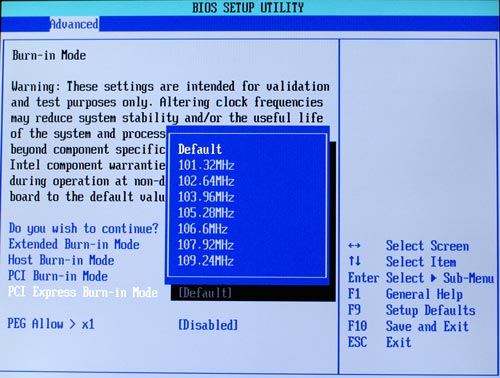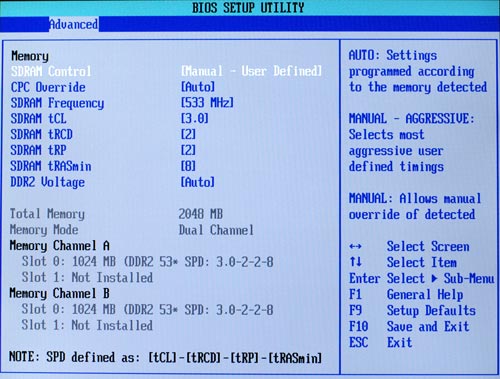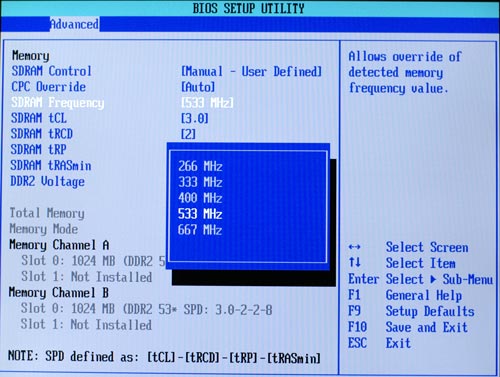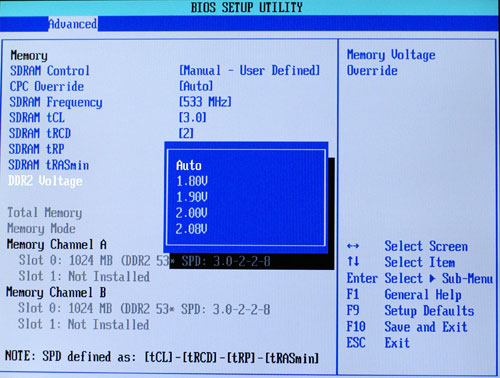Pentium 4 3.46 Extreme Edition and 925XE: 1066MHz FSB Support is Here
by Anand Lal Shimpi on October 31, 2004 3:00 PM EST- Posted in
- CPUs
Intel D925XECV2: Enthusiast Options
The new Intel 925XE includes adjustments for memory timings, memory speeds, memory voltage, and CPU FSB adjustments. These options are well-hidden in the Intel BIOS, but they are much more complete than you might expect on an Intel board.

The Main menu provides system information, but there is little indication of what is lurking inside the Intel BIOS. The real action for the Enthusiast is in the Advanced menu.

In the Advanced menu are the options to adjust PCI, Boot, Peripheral, Drive, Floppy, Video, USB, etc. The main controls for the Enthusiast are found in the Chipset Configuration menu

Chipset Configuration includes two important sub-menus - Burn-In Mode and memory

Continue and Extended Burn-In Mode should be enabled. You can then select Host Burn-In Mode.

Host Burn-In Mode now reveals an adjustment range of -2% to 10% in 1% increments. With a base frequency of 266 or 1066FSB, this is an adjustment range of 1045 FSB to 1173 FSB in 10.66MHz increments. While this is a very limited range compared to the average Enthusiast board, it is certainly a beginning for Enthusiast controls on an Intel board.

PCI speed can be adjusted form the default 33.33 to 36.36 and 40.0.

PCI Express also has an adjustment range from the default 100 to around 110 in 1.32Mhz increments.
Returning to Chipset Configuration, the Memory sub-menu has a wide range of memory adjustments.

After selecting Manual-User Defined you can select memory timings. This includes CAS Latency (tCL), RAS-to-CAS Delay, tRP., and tRAS.

DDR2 Memory Speed can be adjusted to base frequencies of 266, 333, 400, 533, and 667.

It was particularly surprising to find a reasonable range of memory voltage adjustments in the Intel BIOS. The available range is from default 1.8V to 2.1V. this is wide enough to allow many DDR533 rated DDR2 dimms to run at DDR667 or faster.
There are just two major controls missing for the Enthusiast. There is no option in the BIOS that we could find to adjust the base CPU frequency. If this could be forced to lower standard speeds such as 200 (800), there would be much more flexibility available for controlling the CPU. There is also no provision for CPU voltage, which is becoming less important as processor operating voltages have decreased. Our test CPU did have limited multiplier adjustments of 12X-13X but we do not know if shipping 1066 processors will also have this feature.
We could wish for wider ranges on several options, but the good news is this Intel board does contain the kind of tweaking controls Enthusiasts have been asking for from Intel.










63 Comments
View All Comments
Beenthere - Sunday, October 31, 2004 - link
Intel has simply run out of Hail Mary solutions to their unending design, engineering, production, sales, management, and marketing problems. Even Wall Street knows this by now.Wesley Fink - Sunday, October 31, 2004 - link
For those who asked, the 1000 lot Intel price for the 3.46EE is $999.coldpower27 - Sunday, October 31, 2004 - link
Well you could get a direct comparison between the Athlon 64 3700+ vs the Pentium 4 560 as those 2 processors are priced pretty directly against each other on Newegg, though their MSRP differ in actuality.64Bit Windows isn't likely to be released until Prescott 2M with Intel EM64T is released in Q1 2005. We will have to see though if Microsoft will released in 2005 WinXP 64.
jimmy43 - Sunday, October 31, 2004 - link
#14 I was thinking the same thing. The 3500 would probably still win or tie in most of the categories and it costs nearly half the price of an intel 560. I feel like Anand is trying to be fair to both companies and reccomending a bit of both. Realistically, AMD has Intel beat in every market segment... by alot. It's also funny how everyone is COMPLETELY forgetting that AMD's proccessors are 64 bit so in a year or so, you will get a considerable free speed boost and youl be able to run the latest OS. Is that not a huge advantage? Come on, people need to stop overlooking that its really bugging me.DukeN - Sunday, October 31, 2004 - link
Once again, Intel shows why it's the Sony of the CPU world with terrible products terribly overpriced.Gnoad - Sunday, October 31, 2004 - link
I might have missed it, but how much will Intel price this at? Considering it's an EE, one can guess about $900. If thats true, they MIGHT sell 3 or 4 of them.skunkbuster - Sunday, October 31, 2004 - link
underdog in terms of market shareGhandiInstinct - Sunday, October 31, 2004 - link
Since when did the world spin where a chip that is superior in 90% of chip tasks is the underdog?stephenbrooks - Sunday, October 31, 2004 - link
So... I was thinking of investing some money in shares. You don't think AMD might happen to be a good bet right around now, would you?SLIM - Sunday, October 31, 2004 - link
Great review as always, but there's always room for improvement:)[/begin nitpicking]
"So in the end, who takes the crown? AMD or Intel? The 3800+ took four category wins, while the Pentium 4 560 only took two, however with the exception of the gaming and professional apps category, AMD's victories were not overwhelming - especially once you take into account the fact that the 3800+ is priced much higher than the Pentium 4 560. Now that you can purchase at least a couple of 915 based motherboards for less than $130 the total cost of ownership for the Intel platform doesn't eat into the CPU price advantage. For the most part we'd say the 3800+ is faster than the Pentium 4 560 but not always worth the added cost. It's unusual but in many cases, the Pentium 4 560 is actually the bargain high-end chip of the two."
Alrighty, two comments:
1) It's bad science to make a detailed comparison, and then in the conclusion talk about switching the chipset and memory in order to make the price comparison hold up. (Maybe include the numbers from a 915 review to back up the assertion that the 560 will still perform just as well with 915/DDR).
2) I'd be curious to see how the 3500+ would hold up in these same comparisons since it is about $150 cheaper than the 560.
Bonus nitpick:
4 of the graphs don't include the new 3.46ee (ACD on page 9 and 3 games benches); I don't know if that was intentional or not. [/end nitpicking]
Thanks again for the best reviews.